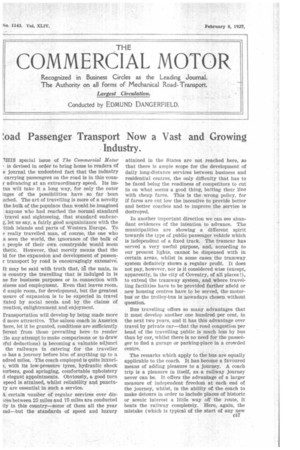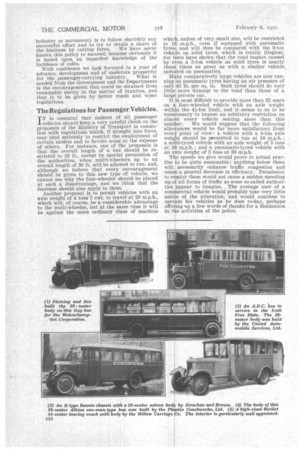oad Passenger Transport Now a Vast and Growing
Page 83

Page 84

If you've noticed an error in this article please click here to report it so we can fix it.
Industry.
1HIS special issue of The Commercial Motor is devised in order to bring home to readers a e journal the undoubted fact that the Industry carrying passengers on the road is in this counyadvancing at an extraordinary speed. Its imtuts will take it a long way, for only the outer awes of the possibilities have so far •been ached. The art of travelling is more of a novelty the bulk of the populace than would be imagined anyone who had reached the normal standard travel and sightseeing, that standard embraclet us say, a fairly good acquaintance with the itish islands and parts of Western Europe. To e really travelled man, of course, the one who s seen the world, the ignorance of the bulk of people of their own countryside would seem thetic. However, that merely means that the Ed for the expansion and development of passenr transport by road is encouragingly extensiv4.
It may be said with truth that, la the main, in Ls country the travelling that is indulged in is tie for business purposes or in connection with siness and employment. Even that leaves room, d ample room, for development, but the greatest msure of expansion is to be expected in travel tated by social needa and by the claims of meation, enlightenment and enjoyment.
rransportation will develop by being made more d more attractive. The saloon coach in America 'here, let it be granted, conditions are sufficiently ferent from those prevailing here to render any attempt to make comparisons or to draw ?fill deductions) is becoming a valuable adjunct the railways in catering for the traveller to has a journey before him of anything up to a ndred miles. The coach employed is quite luxuris, with Its low-pressure tyres, hydraulic shock gorbers, good springing, comfortable upholstery d elegant appointments. Obviously, a good turn speed is attained, whilst reliability and punctuty are essential in such a service.
A. certain number of regular services over disces between 25 miles and 75 miles are conducted ily in this country—some of them all the year Ind—but the standards of speed and luxury attained in the States are not reached here, so that there is ample scope for the development of daily long-distance services between business and residential centres, the only difficulty that has to be faced being the readiness of competitors to cut In on what seems a good thing, baiting their line with cheap fares. This is the wrong policy, for if fares are cut low the incentive to provide better and better coaches and to improve the service is destroyed.
In another important direction we can see abundant evidences of the intention to advance. The municipalities are showing a different spirit towards the type of public passenger vehicle which is independent of a fixed track. The tramcar has served a very useful purpose, and, according to our present lights, cannot be dispensed with in certain areas, whilst in some cases the tramway system definitely shows a regular profit. It does not pay, however, nor is it considered wise (except, apparently, In the city of Coventry, of all places !), to extend the tramway system, and where travelling facilities have to be provided farther afield or new housing centres have to be served, the motorbus or the trolley-bus is nowadays chosen without question.
Bus travelling offers so many advantages that it must develop another one hundred per cent. in the next two years, and it has this advantage over travel by private car—that the road congestion per head of the travelling public is much less by bus than by car, whilst there is no need for the passenger to find a garage or parking-place in a crowded centre.
The remarks which apply to the bus are equally applicable to the coach. It has become a favoured means of adding pleasure to a journey. A coach trip is a pleasure in itself, as a railway journey never can be. It offers the advantage of a larger measure of independent freedom at each end of the journey, whilst, in the ability of the coach to make detours in order to include places of historic or scenic interest a little way off the route, it beats the railway completely. Here, again, the mistake (which is typical of the start of any new Industry or movement) is to follow slavishly any successful effort and to try to obtain a share of the business by cutting fares. We have never known this policy to succeed, because obviously it is based upon an imperfect knowledge of the Incidence of cats. With confidence we look forward to a year of advance, development and of moderate prosperity for the passenger-carrying industry. What is needed from the Government and the Departments is the encouragement that could be obtained from reasonable surety in the matter of taxation, and that is to be given by better roads and wiser regulations.
The Regulations for Passenger Vehicles.
TT is essential that makers of all passenger .1-vehicles should -keep a very careful check on the proposals of the Ministry of Transport in connection with regulations which, if brought into force, may tend seriously to restrict the employment of certain models and to favour some at the expense of others. For instance, one of the proposals is that the overall length of a bus should be restricted to 26 ft., except by special permission of the authorities, when multi-wheelers up to an overall length of 30 ft. will be allowed to run, and, although we believe that every encouragement should be given to this new type of vehicle, we cannot see why the four-wheeler should be placed at such a disadvantage, and we think that the increase should also apply to them. . .
• Another proposal is to permit vehicles with an axle weight of 4 tons 5 cwt to travel at 20 m.p.h., which will, of course, be a considerable advantage to the multi-wheeler, but at the same time it will be against the more ordinary class of machine whic , unless of very small size, will be restricted to 11 m.p.h., even if equipped with pneumatic tyres and will thus be compared with the 9-ton vehi‘ia on solid tyres, which is totally illogical, for t sts have shown that the road impact caused by e en a 5-ton vehicle on solid tyres is nearly thret. times as great as with a. similar vehicle, mon ted on pneumatics.
M ny comparatively large vehicles are now running n pneumatic tyres having an air pressure of only 5 lb. per sq. in. Such tyres should do very little more damage to the road than those of a larg private car.
It s most difficult to provide more than 32 seats on four-wheeled vehicle with an axle weight with n the 4i-ton limit, and itseems to us to be unn essary to impose an arbitrary restriction on almo t every vehicle seating more than this num er. We would suggest that the following allo ances would be far more satisfactory from ever point of view : a vehicle with a 9-ton axle weig t should be permitted to run at 16 m.p.h.; a sol d-tyred vehicle with an axle weight of 5 tons at 21 m.p.h.; and a pneumatic-tyred vehicle with an a le weight of 5 tons at 30 m.p.h.
T e speeds we give would prove in actual practice o be quite reasonable ; anything below them will necessarily enhance traffic congestion and cans a general decrease in efficiency. Permission to ell iloy them would not cause a sudden speeding up oi all forms of traffic as some so-called authorities appear to imagine. The average user of a commercial vehicle would probably take very little notice of the alteration, and would continue to oper te his vehicles as he does to-day, perhaps offe ing up a few words of thanks for a diminution In t e activities of the police.




































































































































































































